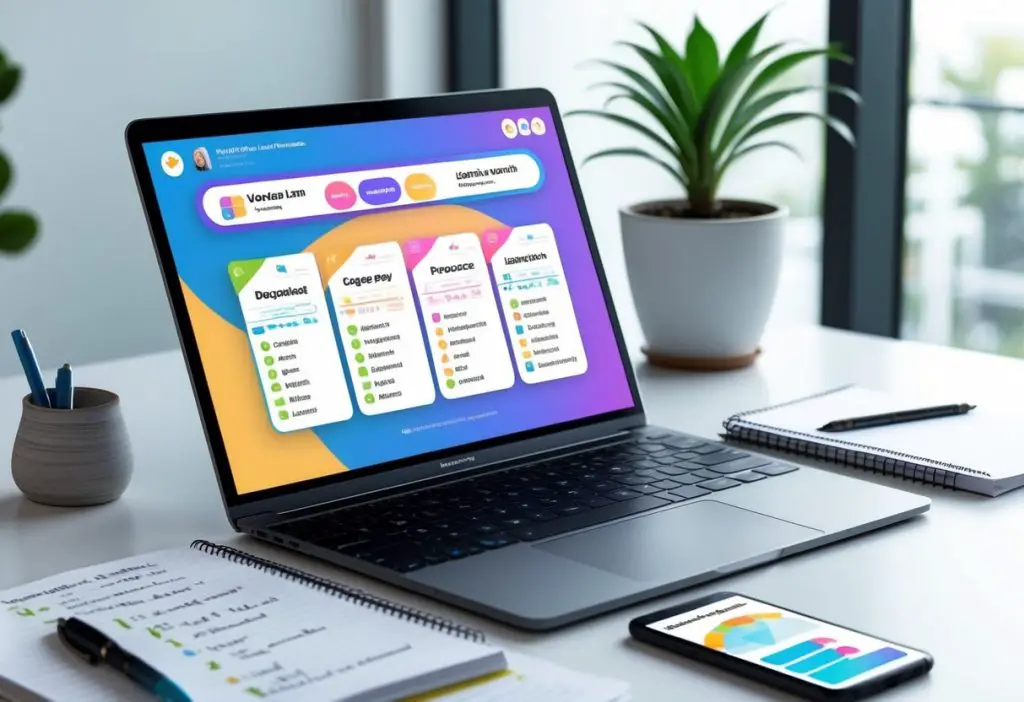When you look for a new way to study languages can you learn, you might wonder if Memrise is worth your time. A Memrise review shows that it offers simple tools, short lessons, and a wide range of languages to practice daily. You can see how it compares to other apps and decide if it fits your learning style.
You want to know if it actually helps you remember words, stays engaging over time, and feels worth the cost. This overview gives you the facts so you can make a clear choice without wasting effort.
Key Takeaways
- Memrise uses short lessons and memory-focused tools
- It covers many languages with flexible course options
- Pricing and alternatives affect its overall value
Key Features and Learning Methods
You learn with tools that focus on memory, practice, and real-world language use. The platform combines repetition, visual aids, and progress tracking to help you stay consistent and improve step by step.
Spaced Repetition System
You review words and phrases at intervals designed to strengthen memory. This spaced repetition system schedules items just before you are likely to forget them, which makes recall stronger over time.
You don’t need to guess when to review because the system handles the timing. This reduces wasted study time and keeps your sessions efficient.
The platform also offers a Speed Review mode. In this mode, you answer quickly under time pressure, which forces you to recall words faster and with less hesitation. This helps you practice active recall instead of passive recognition.
By repeating content at the right moment, you build long-term memory instead of short-term cramming. This method works well for vocabulary because it balances review with new language learning.
Flashcards and Mnemonics
You learn new words with flashcards that display the word, translation, and sometimes an image. These cards make it easy to practice in short sessions.
The system also encourages you to use mnemonics. You can create your own memory aids or use ones added by other learners. For example, linking a word to a picture or phrase helps you remember it faster.
Flashcards are interactive, not static. You may see multiple-choice questions, typing exercises, or listening tasks. This variety prevents repetition from feeling dull and keeps you engaged.
Because you can revisit cards as often as needed, you control how much time you spend on each word. This flexibility makes it easier to focus on harder language.
Native Speaker Videos and Pronunciation Practice
You watch short clips of native speakers using words and phrases in everyday speech. These videos expose you to natural accents, tone, and rhythm.
You also get pronunciation practice by repeating after the speaker. Some exercises ask you to record your voice and compare it to the native version. This helps you notice mistakes in stress, intonation, or sound.
Hearing real people instead of computer voices makes listening practice more realistic. You adjust to different voices, speeds, and accents, which prepares you for real conversations.
This feature is especially useful if you want to improve speaking and listening, not just reading and writing. It connects word study to real-world usage.
Gamification and Learning Statistics
You track your progress through learning statistics such as words learned, review streaks, and accuracy rates. These numbers give you a clear picture of your improvement.
The app uses gamification to keep you motivated. You earn points, badges, and streaks for completing lessons. This rewards consistent practice and makes studying feel less like a chore.
You can also compare your progress with past sessions to see if your accuracy improves. This feedback helps you adjust your study habits and focus on weak areas.
By combining data with rewards, the platform encourages steady learning. You see both short-term achievements and long-term growth, which keeps you engaged over time.
Memrise Reviews: Course Selection and Language Coverage

You can choose from a wide range of languages, including popular global options and harder-to-find ones. The platform also offers both official courses and community-driven content, giving you flexibility in what and how you study.
Official Memrise Courses
Official Memrise courses cover many major foreign languages. You will find structured programs for English, Spanish, French, German, Italian, Chinese, Japanese, Korean, and Arabic. These courses are built by the Memrise team and usually include audio, video, and word lists.
Each official course often follows a clear sequence. You start with beginner levels and progress toward more advanced grammar and language learning. This makes it easier to track your learning and measure progress over time.
The lessons usually focus on practical phrases and everyday communication. For example, you might learn greetings, ordering food, or asking for directions before moving to more complex topics. This approach helps you use what you learn right away.
User-Created and Community Content
This also offers you access to user-created content made by the Memrise community. These courses cover many areas that the official ones do not. For instance, you can find vocabulary lists for exams, slang, or even niche topics like history or science terms in different languages.
The quality of these courses can vary. Some are well-structured and detailed, while others may lack consistency. Still, this wide selection gives you the chance to explore beyond the official catalog.
Community content is especially useful if you want to study less common languages. You might find courses for Finnish, Turkish, Vietnamese, Thai, or Dutch that may not be as developed in the official section. This flexibility makes the platform more adaptable to your needs.
Support for Less Common and Sign Languages
If you are interested in less common languages, Memrise includes options you might not find elsewhere. You can study Nordic languages, Bahasa, and even Native American languages through community-built courses. While the depth may vary, it gives you the chance to explore languages with fewer resources online.
Sign languages are also available through user-generated content. For example, you can find courses in American Sign Language (ASL) or British Sign Language (BSL). These courses often rely on community videos or images, which makes them different from text-heavy lessons.
This variety helps you learn languages that are often overlooked on other platforms. It also allows you to connect with communities that share cultural and linguistic interests.
Course Structure and Levels
Most Memrise courses follow a level-based system. Each level contains a set of words or phrases, often grouped by theme. For example, one level might focus on food vocabulary, while another covers travel expressions.
You move through levels in order, and the platform tracks your progress. This structure makes it easier to review words you struggle with while reinforcing what you already know.
Official courses tend to be more polished, with clear progression. Community courses may vary, but many still use the same level format. This consistency across the platform helps you adapt quickly, no matter which type of course you choose.
User Experience and Effectiveness

You can use Memrise in different ways depending on your learning goals. The platform gives you tools for mobile learning, practice for speaking and listening, and a community that supports your progress. It’s a great language learning experience.
Mobile App and Offline Learning
The Memrise mobile app works on both iOS and Android. You can study vocabulary, phrases, and short lessons directly from your phone. The interface is simple, with clear buttons and progress tracking that help you stay organized.
Offline mode lets you download lessons in advance. This feature is useful if you travel often or have limited internet access. You can continue learning without interruption, and your progress syncs once you reconnect online.
This language-learning app also includes spaced repetition. This system shows you words at the right time to improve memory. You can adjust daily goals, review sessions, and notifications to fit your schedule.
Key points about the app:
- Available on iOS and Android
- Offline mode for downloaded lessons
- Spaced repetition for better recall
- Customizable daily goals
Suitability for Beginners and Advanced Learners
If you are a beginner, Memrise gives you simple vocabulary lists and basic sentences. The lessons start with common words and phrases so you can build a foundation. The short quizzes and repetition make it easier to remember new terms.
For advanced learners, the platform offers more complex materials. Some courses include idioms, grammar points, and longer sentences. You may also find user-created courses that cover niche topics or specific dialects.
The structured paths suit beginners best, while advanced learners may need to combine Memrise with other resources. The app does not always provide deep grammar explanations, so you may need outside study for full understanding.
Comparison of focus levels:
| Level | Focus Areas | Best Use Case |
|---|---|---|
| Beginners | Vocabulary, short phrases, basics | Building foundation and daily practice |
| Advanced | Idioms, complex phrases, user courses | Expanding vocabulary, refining skills |
Speaking and Listening Skills
Memrise includes listening exercises with native speaker audio. These clips help you hear natural pronunciation and rhythm. You can replay audio as many times as needed, which supports better listening practice.
For speaking practice, the app uses short recording tasks. You repeat phrases into your microphone and compare your voice with the model. While this helps with pronunciation, it does not replace real conversation.
Some courses also include video clips of native speakers. These show natural expressions and tone, which add context to the words you learn. The chatbot feature gives you basic simulated conversations, but the range of responses is limited.
Strengths: clear audio, video examples, pronunciation practice
Limitations: no live feedback, limited conversation depth
Memrise Community Engagement
The Memrise community adds another layer to your learning. You can join discussions, ask questions, and share tips with other learners. This interaction helps you stay motivated and connected.
Many courses are user-created. These allow you to study topics outside the official language courses, such as slang or regional vocabulary. The variety can be useful if you want to explore beyond standard lessons.
The community also supports leaderboards and progress comparisons. You can see how your study time and scores compare with others. While this may motivate some users, it may not appeal if you prefer private study.
Community features include:
- User-created courses
- Discussion forums
- Leaderboards and progress tracking
- Shared study tips and resources
Pricing, Subscriptions, and Alternatives

Memrise offers both free and paid options, with each tier unlocking different tools and features. You can choose between monthly, yearly, or lifetime plans, and compare them with other language learning apps to see which fits your needs best.
Free vs Paid Subscription Options
You can use Memrise for free, but the free version is limited. It gives you access to community-created courses, flashcards, and basic reviews. This is enough if you want to try out the platform or practice vocabulary without spending money.
The paid subscription, called Memrise Pro, adds more learning tools. You get grammar lessons, listening practice with native speakers, and personalized review sessions. These features aim to improve speaking and comprehension, not just vocabulary.
A simple breakdown:
| Plan | Access | Key Features |
|---|---|---|
| Free | Limited | Courses, flashcards, reviews |
| Paid (Pro) | Full | Grammar, listening, native videos, personalized review |
If you only want casual practice, the free tier works. If you want structured progress, the paid subscription is more useful.
Memrise Pro and Premium Features
Memrise Pro is the main paid option. You can subscribe monthly, yearly, or at a discounted multi-year rate. The features focus on helping you practice real-world language skills.
With Pro, you get “Learn with Locals” videos that show native speakers using everyday phrases. You also get listening skills practice, which helps you understand fast speech. The difficult words mode lets you review terms you often forget.
Another benefit is offline mode, so you can study without an internet connection. This makes it easier to use while traveling. You also gain access to more detailed progress tracking compared to the free version of Memrise.
When you pay for Pro plan, Memrise does not include live tutoring or one-on-one lessons. It is still focused on self-study, but the added features make it more complete than the free plan.
Lifetime Membership and Unlimited Access
If you do not want to pay every month, Memrise offers a lifetime membership. This is a one-time payment that grants unlimited access to all Pro features. You never need to renew or worry about subscription fees again.
This plan is most cost-effective if you plan to use Memrise for several years. For example, paying for three to four years of yearly Pro can cost more than the single lifetime fee.
The lifetime option includes everything in the premium subscription, such as offline mode, grammar practice, and native videos. It is the same as Pro but without time limits.
However, you should consider how long you plan to study with Memrise. If you only want to use it for a few months, a monthly plan is cheaper.
Comparison with Other Language Learning Apps
When comparing Memrise with other language apps, you will notice different strengths. Duolingo focuses on gamified lessons with a free model supported by ads. It has more structured grammar practice but fewer real-world videos.
Anki, on the other hand, is a flashcard app. It is powerful for memorization, but it requires more setup and does not include native video or listening tools. Memrise is easier to start with, while Anki is better for advanced learners who want full control.
Other apps like Babbel or Busuu offer conversation practice and grammar-focused lessons. These often cost more than Memrise but may include speaking practice with tutors.
Memrise stands out for its native speaker videos and focus on vocabulary in context. If you want a balance of structure and exposure to real speech, it offers something different from Duolingo or Anki.
Frequently Asked Questions
You can choose between free and paid features, compare them with other apps, and decide if it fits your learning style. The platform also raises questions about safety and how it stacks up against traditional study methods.
What are the main differences between Memrise’s free and paid versions?
With the free version, you get access to basic courses, vocabulary practice, and community-created content.
The paid version adds offline mode, grammar review exercises, listening practice, and more detailed learning statistics.
How does Memrise compare to Duolingo in terms of language learning journey effectiveness?
Memrise focuses heavily on vocabulary and real-world phrases, often using video clips of native speakers.
Duolingo emphasizes grammar and structured lessons with a game-like format. Your choice depends on whether you want more natural speech exposure or step-by-step grammar practice.
Is Memrise considered a safe platform for language learners?
Yes, Memrise is generally safe to use. It does not require sensitive personal information beyond a standard account setup.
You can use it on both the web and mobile without major security concerns.
What are the benefits of using the Memrise app over other language learning methods?
You get short, repeatable lessons that fit into a busy schedule. The app uses spaced repetition to help you remember words more effectively.
Hearing native speakers through video clips gives you more natural listening practice than many textbook-based methods.

